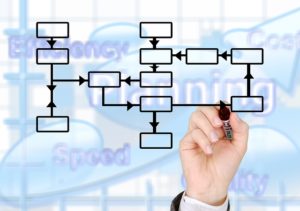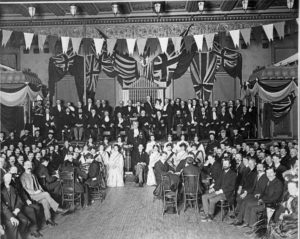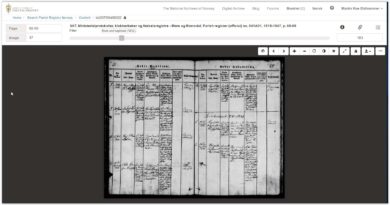Cluster genealogy
Cluster genealogy can be a way to break through a brickwall.

Cluster genealogy is a research technique [were we try] to learn more about an ancestor by examining records left by [or information about] the ancestor’s cluster. A person’s cluster consists of the extended family, friends, neighbors, and other associates such as business partners. Researching the lives of an ancestor’s cluster leads to a more complete and more accurate picture of the ancestor’s life. (Wikipedia)
Emily Ann Coom puts it very nicely: “If you’re trying to travel from point A to point B and the road is washed out, you might have to travel to point C to reach B” (Croon, 2006)
It is especially useful in Norwegian genealogy as there were so many people with the same names. I assume you are familiar with Norwegian naming. If not, I suggest you read my article linked at the end of this article. Here is a short recap:
Everybody had a first (given) name. Next came the patronym which is the name of the father with the suffix -sen, -son or -søn for boys and -dotter/-datter for girls. Usually the name of the farm where they lived were added at the end. E.g. Hans Olsen Berg: Hans, the son of Ole, living at the farm Berg. If the person moved, the name of the farm would change.
Also Norwegian renaming traditions gives us a lot of people with similar names. See link to article at the bottom of this page
 Cluster genealogy is the opposite of direct line genealogy. I know some genealogists don’t spend time recording siblings. That is perfectly ok. However, when applying cluster genealogy, we spend time recording each en everyone in our target’s family. We might even get to the point where we record the people in a person’s neighbourhood. You might also want to see if your “target” has been the witness to events, and in case, who are the main persons of this event.
Cluster genealogy is the opposite of direct line genealogy. I know some genealogists don’t spend time recording siblings. That is perfectly ok. However, when applying cluster genealogy, we spend time recording each en everyone in our target’s family. We might even get to the point where we record the people in a person’s neighbourhood. You might also want to see if your “target” has been the witness to events, and in case, who are the main persons of this event.
In my work with Norwegian genealogy I have been able to build cases by looking at the witnesses (Godparents) at births, and best men at weddings. Having studied the extended family I have been able to make connections where the person’s vital data were scarce. The information we find may be classified as “circumstantial evidence”, but when enough of this evidence is stacked up, it makes a stronger case.

It is impossible to try to list all the connections you might want to look for. Here are some suggestions:
- Who was the witnesses to your target’s baptism?
- Who was the witnesses to your target’s wedding?
- Who was the witnesses to your target’s children’s baptism?
- Who were your target’s neighbours? (People in the parish with the same farm name)
- Who did your target work for? (Employers may be relatives)
- Did your target go to sea? Who was the rest of the crew? The owner of the boat?
- Did your target migrate within Norway? Look from other people who travelled to and from the same community.
- Who did your target travel with when he/she emigrated?
- Where did your target settle in their new country? (Immigrants often went to areas with people they knew had already settled).
This list could probably be much longer. You may need to go through the same procedure for all you target’s children, siblings, uncle/aunts, grandparents etc.
The sources for this are the vital records we use every day. Probate records may be a treasure trove.
By recording this information you may see emerging patters. I have looked at migration patterns lately and found two men I believe to be brothers. The were both fostered with different families in different parishes, but both moved from Trøndelag to Tromsø and appear together at several events.
If you have your ancestry available online, by doing cluster genealogy, you may easier draw attention from people researching the same line (“cousin bait”). They may have vital and interesting information to share.
Family group sheets are great starting points when doing cluster genealogy. You can find a blank one in my downloads section. Other than that I use my genealogy software. I use Legacy family tree. This software has a feature called “shared events”. This can be a good tool when linking people together. Other genealogy softwares may have similar features.
Cluster genealogy takes time, however, it is worth it as it can be the way to break down brickwalls.
Norwegian naming
Norwegian renaming traditions
Sources:
Emily Anne Croom: “In good company” Family tree magazine. Published July 28, 2006






Excellent points. I do this all the time, though more with family than friends and neighbors since most of my ancestors lived in big cities in apartment buildings with hundreds of neighbors. But I do research all the siblings and their children and so on, perhaps to a ridiculous extent!
Hello Amy
Thanks for visiting and for taking the time to comment. These points may hold the clues needed to break through a brick wall.
Good points. I began to do that a long time ago, particularly baptism records and marriage records where sponsors and attendants were listed. Most people didn’t go too far from family for those occasions and triangulation of names can be very useful.
Hello Eileen
Thanks fo visiting and for taking the time to comment. Direct line genealogy is ok. Everyone gets to decide how to do their research. However, when the sources run dry it is time to start looking at alternatives.